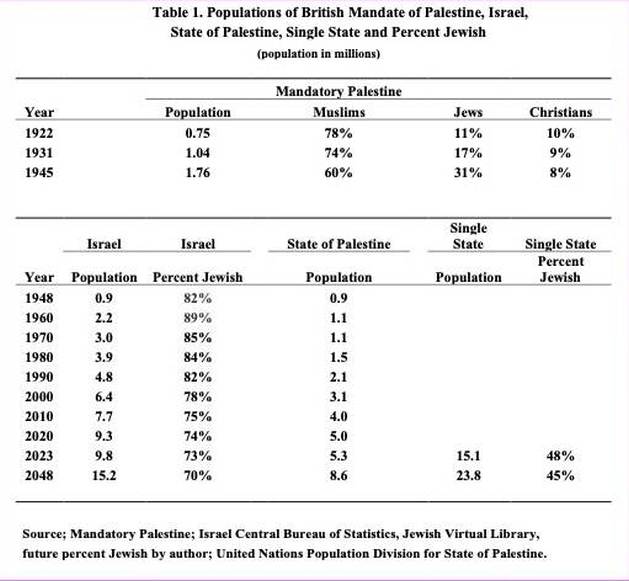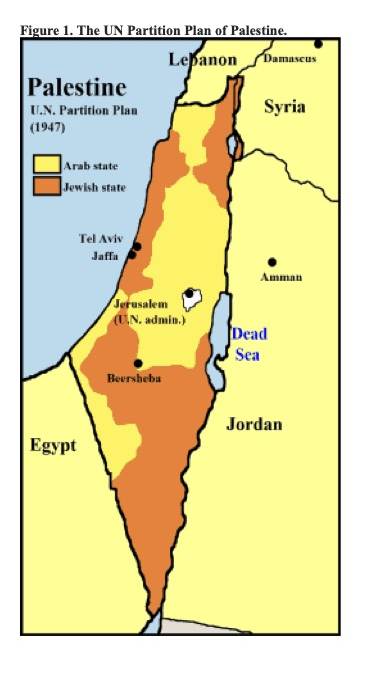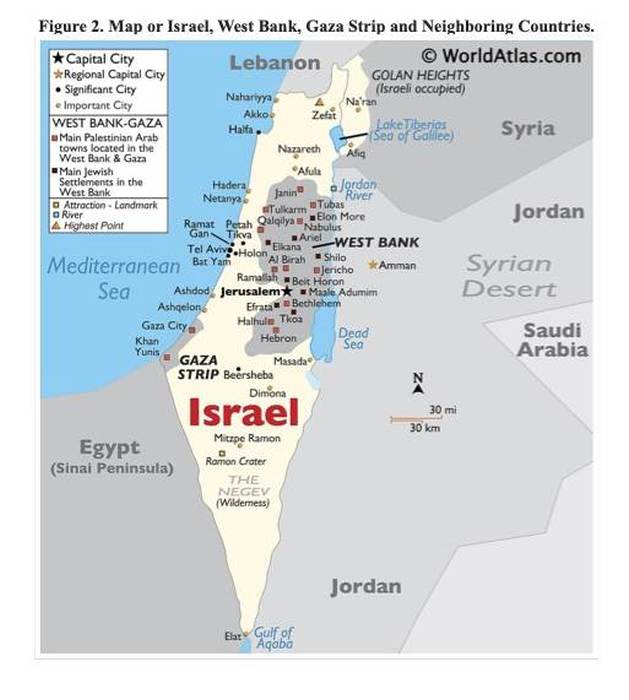Israeli-Palestinian Conflict: Religion & Demographics

PORTLAND, USA, Feb 14 (IPS) - Together religious identity and demographics play an important role in the decades-long conflict between Israelis and the Palestinians. If the Palestinians, who are largely Muslim and Christian, had been Jewish, they would have been allowed to live in their homes on their lands and be entitled to be Israeli citizens.
According to Israel’s Law of Return (??? ?????, ?ok ha-shv?t), passed by the Knesset on 5 July 1950, people, including Palestinians, with one or more Jewish grandparent and their spouses have the right to relocate to Israel and acquire Israeli citizenship, assuming they pose no threat to the country and are not dangerous criminals.
The British Mandate Past
The British Mandate for Palestine, or Mandatory Palestine, was approved by the League of Nations in 1922. The religious composition of the population of Mandatory Palestine was predominantly non-Jewish. Among the resident population at that time, approximately 11 percent were Jewish, 78 percent were Muslims, and 10 percent Christians (Table 1).

As a result of Jewish migration to Mandatory Palestine, largely from Eastern Europe, the religious composition of the resident population underwent noteworthy change. The estimated numbers of Jewish migrants to Mandatory Palestine during the 1920s, 1930s, and from 1940 to 1945 are 100,000, 223,000, and 45,000, respectively, resulting in a total of 368,000.
By 1945, the Jewish population in Mandatory Palestine had increased tenfold and the proportion Jewish nearly tripled to 31 percent. Also, the non-Jewish population in Mandatory Palestine doubled and the majority of the population continued to be non-Jewish, i.e., 60 percent Muslim and 8 percent Christian.
Becoming a politically active movement at the end of the 19th century, the Zionist movement recognized that their dream of creating a “Jewish” state in historic Palestine would need to be unencumbered by the native population of non-Jews. In other words, the establishment of a Jewish state would necessarily involve the displacement or expulsion of the land’s current non-Jewish residents.
After decades of violent confrontations between the Jewish and non-Jewish populations in Mandatory Palestine and various attempts by the British and others to resolve the conflict, the Palestine problem was turned over to the United Nations to resolve. In 1947, the United Nations adopted the Solomonic proposal terminating the Mandate and dividing Palestine into two states, largely resulting demographically in one Jewish and one non-Jewish, i.e., primarily Muslim and Christian (Figure 1).

Although in 1947 about one third of the population in Mandatory Palestine was Jewish, the United Nations General Assembly Resolution 181 (II) allocated 55 percent of the land to the Jewish state. Consequently, neighboring Arab countries and the non-Jewish population of Mandatory Palestine rejected the proposal.
Following the United Nations proposal to partition Mandatory Palestine into two states and various actions that were undertaken for the creation of the Jewish nation of Israel on 14 May 1948, the demographic composition of the territory underwent significant changes with the displacement and dispossession, or the Nakba??????) ) , of an estimated 750,000 non-Jewish Palestinians from Israel.
In the newly founded nation of Israel with a population of 873 thousand, the proportion Jewish was 82 percent. If the non-Jewish Palestinian population had not been displaced but had remained in their homes, the Jewish population in Israel would have been about half of its actual 1948 level, or about 43 percent.
Following its establishment in 1948 and the war involving neighboring Arab states, the borders of Israel expanded to 77 percent of the original territory of Mandate Palestine, including the larger part of Jerusalem. Also, after the 1967 Arab-Israeli war, Israel’s population with the support and resources of each Israeli government began expanding Jewish settlements in the occupied territories of the West Bank and the Gaza Strip (Figure 2).

Today approximately 700 thousand Israeli settlers are living in 279 settlements across the West Bank and East Jerusalem. Recently, some Israelis and far-right Israeli lawmakers are rallying support in the country to reestablish Jewish settlements in the Gaza Strip, which Israeli authorities and Jewish settlers vacated in 2005.
Most countries deem the Jewish settlements built on land Israel occupied in the 1967 Arab-Israeli war as illegal. The continued expansion of Israeli Jewish settlements remains among the most contentious issues between Israelis and the Palestinians as well as the international community.
Options to address the conflict
Seventy-five years after its creation, the Jewish proportion of Israel is approximately 73 percent. Again, if the current non-Jewish Palestinian inhabitants in the West Bank and the Gaza Strip were permitted to become Israeli citizens, the Jewish population in the demographically enlarged Israel would instead be approximately 48 percent.
Various options have been proposed to address the nearly century-long conflict that began following the establishment of the British Mandate for Palestine. Among those options are the one-state solution, a federation of Palestinian provinces, the transfer of the Palestinians from the occupied territories and the two-state solution (Table 2).

Same rights, justice and equality for Jews and non-Jews, which is generally the case among Western democracies. Some believe that a one state reality, or a de facto single state, already predominates in the territories controlled by Israel. Accordingly, they maintain that it’s time for Israelis and Palestinians as well as the international community to revise their attitudes to resolving the conflict.
A national poll conducted several years ago by the Pew Research Center found that most Israeli Jews, 79 percent, say Jews deserve preferential treatment in Israel. In addition, in 2018, the Knesset passed the Nation-State law that states, among other things, the Jewish people’s right to self-determination, which it restricts to the Israel’s Jewish population, establishes Jewish settlement as a national value and mandates that the state will labor to encourage and promote its establishment and development. Also importantly, as noted above, the one-state solution would result in the Jewish Israeli population becoming a minority of approximately 48 percent.
A federation of Palestinian provinces would not meet the needs and aspirations of the Palestinians. After decades of conflict, displacement and statelessness, Palestinians desire a full-fledged independent nation of their own.
Although objectionable to many, the expulsion, transfer or emigration of Palestinians to other countries has been proposed by some far-right Israelis and their supporters. That demographic change would be followed by Israeli civilians resettling the vacated territories including most recently the Gaza Strip area.
Also according to the national poll by the Pew Research Center, nearly half of Jewish Israelis indicated that Arab Israelis should be expelled or transferred from Israel. Many Jewish Israelis envision a return to ancient Greater Israel with the Jewish inhabitants being the overwhelming majority and the law enshrining Jewish supremacy over the entire geographic area.
The often cited two-state solution to resolve the conflict is the preferred option of many countries both inside and outside the region, including Israel’s main political supporter and economic benefactor the United States. However, the current Israeli government is against the creation of a Palestinian state.
In addition, a Gallup survey taken in the last few months of 2023 found a clear majority of Israelis, two-thirds of Israeli adults, do not support the existence of an independent Palestinian state. Also, only one in four Palestinians, 24 percent, supported a two-state solution when surveyed between July and September 2023.
Prospects for peace
Admittedly, achieving a just, equitable and comprehensive solution to the Israeli-Palestinian conflict, including the two-state proposal, is indeed a formidable undertaking with many serious challenges. Those challenges have been heightened in the aftermath of the October 7 brutal Hamas attack on Israelis and Israel’s war in Gaza that has resulted in a great number of Palestinian civilian deaths and vast destruction of homes and infrastructure.
Nevertheless, despite the daunting challenges including salient demographic realities and ingrained religious identity, a negotiated peace between Israelis and Palestinians is certainly achievable in the near term and would lead to innumerable benefits.
An Israeli-Palestinian peace agreement would foster beneficial relationships, promote economic cooperation and advance mutual understanding in this strategically important region. The demographics of being Jewish or non-Jewish would then diminish as an underlying source for conflict and hostilities among Israelis and Palestinians. And importantly, Israelis and Palestinians would reap the rewards of peace, including the prospects for better lives for themselves and for the populations of future generations.
Joseph Chamie is a consulting demographer and a former director of the United Nations Population Division. He is the author of numerous publications on population issues, including his recent book, "Population Levels, Trends, and Differentials".
© Inter Press Service (2024) — All Rights Reserved. Original source: Inter Press Service
 Global Issues
Global Issues